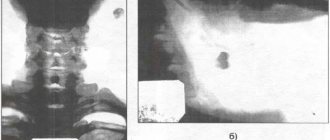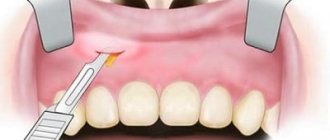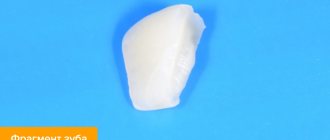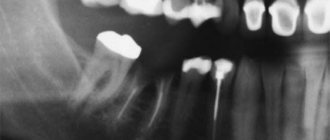- Tooth extraction
- Removal of a tooth cyst
- Bone tissue augmentation
- Resection of the apex of the tooth root
- Installation of a dental implant
- Installation of a mini-implant
Patients have more chronic dental diseases than acute ones. Advanced caries, pulpitis, periodontitis lead to the fact that after a few months or years the patient is faced with a neoplasm on the root of the tooth or its acute inflammation. In this case, resection helps to save the tooth.
When should tooth resection not be performed?
- The main condition for successful root resection is the presence of sufficient jaw bone volume in the patient - at least 5 mm, otherwise there is a risk of jaw fracture.
- A tooth root resection operation will be ineffective if the patient has chronic periodontitis and/or periodontitis, as well as mobility of the diseased tooth.
Tooth root resection is contraindicated if:
- Large cysts or granulomas, when they reach the size of a third of the tooth root or more.
- A completely destroyed dental crown, if the tooth cannot be replaced with prosthetics.
- Close proximity of the roots of healthy teeth.
- Severe mobility of the diseased tooth.
- Some common diseases, such as diabetes, blood diseases, heart diseases, immunodeficiency conditions.
Alternative to apicoetomy
Not in every case, surgical intervention is the only and mandatory method for eliminating granulomas and cysts. Apicoetomy is considered mandatory only in the presence of cysts measuring 1.5-2 cm or larger. The structure of the cyst shell is quite thick and dense and does not disappear completely even with the highest quality therapy.
In the presence of small pathogenic formations, dentists carry out therapeutic treatment. First, the doctor removes the source of infection from the root canals, after which he fills the canals with a special medicinal paste.
After a few months, the patient is sent for an x-ray, based on the results of which the doctor assesses how much the cyst has decreased in size. If everything is normal, then the dentist installs permanent fillings.
The disadvantage of this method is the need for multiple visits to the dentist. It should also be noted that conservative treatment does not always provide the desired effect, since the problem unit periodically becomes inflamed. Therefore, it is much easier and more expedient to eliminate the cyst by cutting off the root tip or completely removing the tooth root.
Do I need to do a resection or still remove the tooth?
Tooth root resection is a tooth-preserving operation. The dentist will recommend it to you when there is at least the slightest opportunity to save the tooth. If the dentist does not see this possibility, then the conversation will immediately focus on removal.
When will the tooth have to be removed?
- You have a large cyst that affects more than a third of the tooth or several teeth.
- The root of the tooth is destroyed.
- There is severe inflammation of the tissues adjacent to the diseased tooth.
- The tooth is movable.
- Subsequent prosthetic replacement of a diseased, destroyed tooth with a crown is impossible.
Our doctors
7 years experience
Exuzian
David Samvelovich
Dental surgeon-implantologist.
Moscow State Medical and Dental University, specialty “Dentistry” - 2013
Implantation surgeries, bone grafting, sinus lifting, tooth extraction of any complexity, any surgical procedures.
More about the doctor...
10 years of experience
Makushkin
Anton Alekseevich
Dental surgeon-implantologist.
Graduated from the Russian State Medical University named after academician I.P. Pavlov in 2009.
From 2009-2010, intern at the Department of General Dentistry and Anesthesiology of the A.E. Evdokimov Moscow State Medical University. from 2010-2012, resident at the Department of Faculty Surgical Dentistry and Implantology of the A.E. Evdokimov Moscow State Medical University. from 2012-2015 postgraduate student of the Department of Surgical Dentistry and Implantology of the A.E. Evdokimov Moscow State Medical University.
More about the doctor...
How is tooth root apex resection performed?
For the patient, resection of the apex of the tooth root is a simple operation and the procedure is tolerated quite easily.
First, the doctor makes an incision in the gum and bone tissue of the jaw to create access to the tumor. After which the tumor itself is removed along with the affected part of the tooth root. The entire cavity is thoroughly cleaned so that not even a small amount of infected tissue remains and is treated with an antiseptic.
Synthetic bone replacement materials are placed into the resulting space, which will take root over time and completely restore the patient’s bone.
Next, the wound is closed with a special self-absorbing membrane and the gum is sutured.
In order to protect the injured area, a bandage may be applied to the gum for up to 1 week.
After surgery, the patient may experience swelling of the gums and pain when chewing, which normally should subside within a few days.
Healing of the mucosa usually occurs in 7-10 days, the bone is restored in approximately 3-4 months.
What causes complications?
Negative consequences often arise either due to medical error or the fault of the patient during rehabilitation. Causes of resection complications:
- Late filling. This procedure is carried out 1-2 days before the apexectomy, otherwise there is a risk of inflammation occurring after the operation as a negative reaction.
- Poor quality filling. The canals inside the tooth must be sealed, otherwise an inflammatory process will occur if the infection continues to spread.
- Tooth decay. If the treatment is handled incorrectly during surgery, there is a risk of damage to the tooth, which will lead to its loss.
- Unprofessionalism. Sometimes serious damage during surgery is caused by the doctor due to improper use of the instrument or careless handling of it.
- Incomplete resection. If the inflamed tissue and source of infection are not completely removed, then a recurrence of the cyst is possible in the future.
- Tissue infection occurs during surgery due to incomplete sterility or after improper oral care.
- Root destruction. The operation involves removing only the tip of the root, a minimal part of it, but if the dentist makes a mistake, the root can completely collapse, causing the tooth to become loose.
- Failure of the patient to comply with postoperative appointments. Proper care, lack of physical activity, diet and other medical prescriptions speed up the rehabilitation process.
What to do after tooth root resection?
Root resection is well tolerated by patients and does not cause major problems even in the postoperative period, but it is necessary to follow a number of rules that will alleviate the condition and speed up recovery.
Typically, after surgery, patients are prescribed antibiotics and vitamin supplements. They must be taken strictly as prescribed by the doctor.
It is necessary to maintain gentle but regular oral hygiene and use antiseptic rinses.
You can't overwork your body. During the healing period, it is better to limit physical and emotional stress.
Do not eat hot or hard food, it should be warm and soft.
Preparation and anesthesia
A couple of days before surgery, you will need to fill the canals of your teeth. It is important to observe the timing of this procedure: it should not be carried out in advance (optimal time: one to two days before the operation). Resection is performed under local anesthesia, which eliminates any discomfort for the patient. The area of the jaw where the mucous membrane meets the gum is exposed to its action, so the surgeon has the opportunity to make an incision to the bone and carefully stitch up the wound.
When surgery is not performed
Like any other surgical intervention, apicoectomy has limitations and contraindications. These include:
- Mobility of teeth II-IV degrees;
- destruction of the crown part of the tooth (more than 50%);
- the presence of cracks in the affected root;
- severe curvature of the root canal (impossible to fill);
- crowding of teeth, which does not allow identifying the affected root;
- acute infectious, viral disease;
- severe bleeding disorders;
- decompensated diabetes mellitus;
- severe immunodeficiency;
- oncology in the active stage.
Some of the limitations to root resection are the indication for removal of the affected unit. The second part refers to general contraindications to any surgical intervention. The risk of surgery for the patient is assessed individually.
The specialists at the Ilatan Clinic make every effort to save the dental unit, if possible. But if there are direct indications for removal, for example, extensive damage to dental tissue, the doctor will not suggest apicoectomy.
Is it possible to leave it?
Some patients can walk for years with a tooth destroyed to the ground, not realizing that rotting roots are a breeding ground for infection and, at a minimum, provoke constant bad breath. Affected roots absorb bacteria and food particles like a sponge. Over time, plaque and stone form on the remnants of the root, causing the gum tissue to become inflamed.
Often patients ignore the problem, hoping that root removal without a tooth will not be necessary, since it will come out on its own. This is a big misconception - in rare cases, a fragment of a tooth can actually come out, but not its root. Delay will only lead to the root becoming overgrown, which is why the gum will have to be cut to remove the root of the destroyed tooth.
The body's constant fight against infection in the root area means that the human immune system directs part of its resources to solve the problem. Ultimately, this will provoke the development of infection and inflammation, and for patients this turns out to be a surprise every time. In some cases, if the rotten tooth root is not removed in time, infection in the upper jaw can spread to the maxillary sinuses, and in the lower jaw it can lead to a fracture or osteomyelitis.
Signs that a root remains after tooth extraction
If the root remains in the gum after a tooth extraction was performed poorly, then the problem is difficult to identify without diagnosis. But if a lot of time has passed since the extraction, and you feel twitching or pulsation in the area of the missing tooth, acute pain due to mechanical impact, observe redness or bleeding from the gums, or increased temperature, this may very likely indicate the presence of a tooth root remnant. If a root remains in the gum after tooth extraction, the consequences will not take long to arrive. Therefore, as soon as you have such a suspicion, contact a specialist as soon as possible.
Laser removal of dental cyst
If the tumor is small, then laser removal may be used. This is a simple and safe way. A laser beam is passed through the root canal, sterilizing it, and the cyst gradually reduces in size.
Positive aspects of using laser:
- not painful and bloodless;
- fast regeneration;
- disinfection of the inflamed area and, as a result, reducing the risk of spreading bacteria.
The disadvantages include the high cost of the procedure, as well as the availability of a laser device not in all clinics.
Why should you agree to resection?
Before the development of a technique for eliminating inflammation in the deep layers of bone tissue by cutting off the root tip, there were no alternatives to tooth extraction. Despite the flourishing of dental prosthetics and implantation, an artificial organ will never become a complete replacement for a natural one.
Therefore, if, after an examination, a specialist says that resection of the apex of the tooth is necessary, rest assured: this is so. Refusal to undergo surgery will certainly result in irreversible loss of the affected organ.
Where can I remove a dental cyst without extracting a tooth?
If you are concerned about this problem, then we invite you to visit the Implantmaster dental clinic to get rid of a cyst on a tooth by treatment or tooth extraction. For you - qualified specialists, all the necessary ultra-modern equipment and reasonable prices.
The price for removing a dental cyst is determined by the services of an endodontist and a surgeon. Endodontic treatment is required with a microscope, including anesthesia, materials, etc., starts from 6,500 rubles. Removal of the cyst by a surgeon is paid separately—about 10,000 rubles. This cost includes all surgical procedures. Lifetime guarantee for treatment at Implantmaster.
Author:
Indications for surgery
- Poor endodontic treatment leading to inflammation of the root apex;
- the presence of a cyst, granuloma or other neoplasm, no more than 1 cm in diameter;
- perforation of the root walls during filling;
- pin or stump inlay in the dental canal;
- obstruction of the dental canal due to a congenital developmental defect;
- a crown or bridge placed on a tooth.
Recovery period
The entire operation lasts about an hour, the recovery period takes up to six months or more, depending on how quickly the bone tissue regenerates. In the first 1-2 days after the surgical procedure, the patient is bothered by moderate pain, swelling, and redness of the gums. After 3-4 days, the unpleasant symptoms decrease and the condition improves. To ensure that the postoperative period passes quickly and without problems, the doctor will give the necessary recommendations for care, prescribe painkillers, as well as a short course of antibiotic therapy.
What is a dental cyst and how to remove it?
Radical dental cyst is a complex chronic disease. It has its own shell and is filled with purulent contents. The disease progresses on the roots and under the gum. A cyst appears when early infectious inflammation, which is based on pathogenic microflora, is not treated.
Removal of a dental cyst is performed surgically . The tumor can grow, affecting the gums and cheeks from the inside of the mouth. In some cases, sepsis may develop.
All this makes it difficult for the patient to function normally. To cure the disease, conservative methods are used:
- at the beginning of the procedure, the doctor informs the patient about the possible consequences (it is worth making this the first point);
- the doctor performs an opening of the dental cavity;
- cleansing the cavity from affected tissues;
- treatment with solutions of antibiotics and antiseptics;
- Then, within half an hour, the tooth cyst is removed without removing the tooth .
The patient will have a chance for recovery and further normal life. The main feature of this disease is its asymptomatic course. The patient may remain unaware for a long time. The consequences of this disease can lead to another complex process - sinusitis (if the cyst is located near the sinuses). It is imperative to monitor the cleanliness of the oral cavity and the condition of the gums, and also come to the doctor for sanitation on time.











